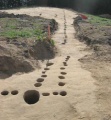RowesdaleTauranga
Summary
Matthew Campbell and Jaden Harris. 2006. Archaeological investigations of site U14/3218, Rowesdale, Tauranga; Season II: final report
Unpublished report for Connell Wagner Tauranga and Rowesdale Developments.The 2006 investigations at U14/3218 have extended our knowledge and understanding of the site, for which excavation is not yet complete. Previous excavation, including the eastern pit cluster and sites U14/1972, a disturbed midden, U14/3235, a pit site that included two houses as well as U14/3207 , a pit site in the neighbouring Richmond park development, had indicated the nature and variation in occupation, as well as its timing and duration. Also the relationship between the occupations and the natural environment was investigated. The separate use of different spaces on the site is becoming clearer, with a cluster of pits in the middle and cooking areas to the west and east on either side, all contained within a palisade.
Overall the sites are dominated by kumara storage pits, but some features excavated in 2005 were found for the first time in the Waimapu, specifically houses and an extensive palisade. The palisaded site is the largest site found so far at Waimapu. Although only two definite houses were found there were strong hints of several others, so that while the pits outnumber the other features, the site can be referred to as a small, semi-permanent village (how permanent is a matter for speculation). The 2005 excavation was neatly contained within the palisade, which served as both a site boundary and a highly visible marker of the presence of the occupants and their right to the land. The 2006 excavation did not encounter the palisade, the line of which runs several metres to the north, and so it remains unclear if Area B is part of the palisaded site.
The 2006 excavations revealed several fairly ordinary pits and a cooking area. Pit 762, on the other hand, was not ordinary – it seems to be unique in the archaeological record in terms of the complexity of sub-features cut into its floor, and hence in terms of the extent and variety of activities that may have taken place there. Just what those activities were is open to interpretation.
Excavation team
- Matthew Campbell
- Ed Ashby
- Karolyn Buhring
- David Carley
- Julie Edwards
- Greg Gedson
- Jaden Harris
- Noel Hill
- Willie Pearson
- Raylene Reihana-Ruka
- Susan Strongman
- Ben Thorne


